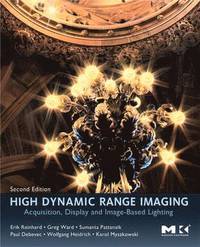
- Format
- Inbunden (Hardback)
- Språk
- Engelska
- Antal sidor
- 672
- Utgivningsdatum
- 2010-07-08
- Upplaga
- 2
- Förlag
- MORGAN KAUFMANN
- Medarbetare
- Heidrich, Wolfgang / Debevec, Paul / Pattanaik, Sumanta / Ward, Greg / Myszkowski, Karol
- Illustrationer
- illustrations
- Dimensioner
- 236 x 185 x 36 mm
- Vikt
- Antal komponenter
- 1
- ISBN
- 9780123749147
- 1612 g
High Dynamic Range Imaging: Acquisition, Display, and Image-Based Lighting
- Skickas från oss inom 10-15 vardagar.
- Fri frakt över 249 kr för privatkunder i Sverige.
Passar bra ihop
De som köpt den här boken har ofta också köpt Co-Intelligence av Ethan Mollick (häftad).
Köp båda 2 för 1232 krKundrecensioner
Fler böcker av författarna
-
Lonely Planet Pocket Oxford & the Cotswolds
Lonely Planet, Greg Ward, Catherine Le Nevez
-
Lonely Planet Kauai
Lonely Planet, Brett Atkinson, Greg Ward
-
Color Imaging
Erik Reinhard, Erum Arif Khan, Ahmet Oguz Akyuz, Garrett Johnson
-
The Ultimate Fly-Fishing Guide to the Great Smoky Mountains
Don Kirk, Greg Ward
Recensioner i media
"With the mainstream introduction of affordable LED HDTVs and computer monitors, the principles of high dynamic range imaging have gone from an academic research topic to essential knowledge. For anyone involved in software or hardware development for computer games and entertainment video, this second edition of High Dynamic Range Imaging offers everything you need and more. Highly recommended."
-Ian Ashdown, President, byHeart Consultants Limited
Övrig information
Erik Reinhard is assistant professor at the University of Bristol and founder and editor-in-chief (with Heinrich Blthoff) of ACM Transactions on Applied Perception. He is interested in the interface between visual perception and computer graphics and also in high dynamic range image editing. His work in HDRI includes the SIGGRAPH 2005 Computer Animation Festival contribution Image-based Material Editing, as well as tone reproduction and color appearance algorithms. He holds a BSc and a TWAIO diploma in computer science from Delft University of Technology and a PhD in computer science from the University of Bristol, and was a post-doctoral researcher at the University of Utah. Wolfgang Heidrich is Associate Professor and Dolby Research Chair at the Department of Computer Science, University of British Columbia. Paul Debevec is a research assistant professor at the University of Southern California and the executive producer of graphics research at USC's Institute for Creative Technologies. Paul's PhD thesis (UC Berkeley, 1996) presented Faade, an image-based modeling and rendering system for creating photoreal architectural models from photographs. Using Faade, he led the creation of virtual cinematography of the Berkeley campus for his 1997 film The Campanile Movie whose techniques were used to create virtual backgrounds in the 1999 film The Matrix. Subsequently he pioneered techniques for illuminating computer-generated scenes with real-world lighting captured through high dynamic range photography, demonstrating new image-based lighting techniques in his films Rendering with Natural Light (1998), Fiat Lux (1999), and The Parthenon (2004). He has also led the design of HDR Shop, the first widely used high dynamic range image editing program. Most recently Paul has led the development of a series of Light Stage devices that allow objects, actors, and performances to be synthetically illuminated with novel lighting. This technique was used to create photoreal digital actors for the film Spider Man 2. Paul received the first ACM SIGGRAPH Significant New Researcher Award in 2001, was named one of the world's top "100 Young Innovators" by MIT's Technology Review in 2002, and was awarded a Lillian Gilbreth Lectureship from the National Academy of Engineering in 2005. Sumanta Pattanaik is an associate processor of computer science at the University of Central Florida, Orlando (UCF). His main area of research is realistic rendering where he has been active for over 15 years and has contributed significantly through a number of research publications. His current focus is developing real-time rendering algorithms and modeling natural environments. He is currently serving as the computer graphics category editor of ACM Computing Review. Sumanta received his MS degree in chemistry from Utkal University, India in 1978 and PhD degree in computer science from Birla Institute of Technology...
Innehållsförteckning
Introduction; Light and Color; HDR Image Encodings; HDR Video Encodings; HDR Image and Video Capture; Display Devices; The Human Visual System and HDR Tone Mapping; Spatial Tone Reproduction; Frequency Domain and Gradient Domain Tone Reproduction; Inverse Tone Reproduction; Visible Difference Predictors; Image-Based Lighting.


